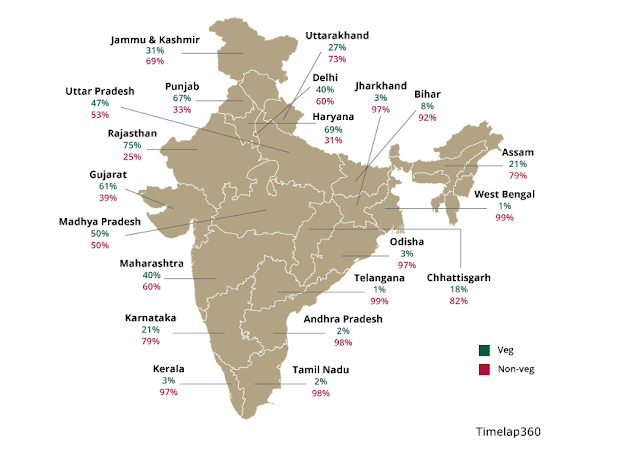8 Common Stereotypes about India
Do these stereotypes about India reflect the reality?
India as a country attracts a lot of stereotypes. But most of these common stereotypes that exist in people's minds are false or are already outdated. Here are 8 common stereotypes about India. Some of these are positive, while most are negative. A lot of these are false, while some are true.
All Indians speak Hindi
People think that all people in India speak Hindi as their primary language. Some great minds also think that Indians speak 'Indian'. But a little do they know that India is one the most diverse countries in terms of languages spoken. Only 40% of Indians have Hindi as their primary language. According to Linguistic Survey of India, there are more than 180 major languages (having more than 10,000 speakers) with around 600 dialects. Some of the dialects sound like a completely different language. So we can say there are hundreds of languages in India. Yet Indians can communicate with each other. Most people know English, while other know Hindi to some extend.
Here is a map of languages in India to blow your mind.
Arranged marriages
Indians are good at Yoga
Yoga has become very popular in the whole world now and people know that it originated in India. This has given birth to a stereotype that all Indians are good at yoga and are flexible for the same reason. Indians must be well known for Yoga, but assuming that every Indian would be good at Yoga; you might be let down. But everyone should try it as Yoga is good for physical and mental health.
Indians are Vegetarian
There are many vegetarians in India. India has the most vegetarians in the world. About 500 million people in India are vegetarian. This number is bigger than the whole population of Latin America. It's not entirely due to religious reasons. Being a vegetarian in India is really easy because vegetarian menu in India is bigger than non-veg menu. India's population is more than 1.3 billion, so everyone in India is not vegetarian. If all Indians were vegetarian then Britain would not have been enjoying its Chicken Tikka Masala. But having so many vegetarians is indeed a positive thing. Being vegan or at least vegetarian is a good thing for planet earth.
This map shows the percentage of vegetarian population in every state of India.
Majority of people in northern India are vegetarians while non-vegetarians in the southern India.
Indians eat with hands
This is true that Indians eat with hands. India is a land of diversity and contrast. One stereotype doesn't define all Indians. First of all, eating with hands is not a bad thing at all. Hands are thoroughly cleaned before eating. Different cultures prevail in different parts of India. People in north-west India use spoons. In most parts of north-east India Chopsticks are in common use. Forks are also used but dinning knives were never a part of culture of common Indians.
Read: least visited country in the world
India is hot
The climate of India can't be generalized into one type. No doubt summers in many parts of India are scorching hot, but it doesn't have same weather throughout the country. You can experience all types of weathers in India, all at the same time of the year. At some places the temperatures can be as high as 50 degrees Celsius and as low as -50 degrees Celsius at others. It depends on the different geographical features of India. Upper Himalayas remain covered in snow throughout the year. India gets a long rainy monsoon season too. Interestingly, unlike other countries, India has 6 seasons. Winter, summer, monsoon, spring, autumn and hemant season.
Indians are obsessed with white skin
Sadly this stereotype is also true for a lot of Indians. A lot of Indians are obsessed with having a fair skin tone. Keep in mind that 'a lot' doesn't mean 'all' or 'most'. Nowadays people are aware that skin colour doesn't matter. What matters is the heart of a person. They no longer use skin colour to judge someone. In fact this idea has gotten so old that 'Fair & Lovely" (a cosmetic brand) had to remove the word 'fair' from its name.
Indians look alike
This is worst stereotype that someone could come up with. Just like the diversity in languages, India has a huge diversity in facial features too. Almost all skin tones can be found in India depending on the region. A stereotypical Indian in the eyes of west would be a brown person with heavy accent like Apu from Simpsons. People from South, North, North-east and other parts look different and unique. Some people in India look like east and south east Asians. Some look like Persian and Arabic. Some are so light-skinned that they almost look Caucasians from Europe.
Even after so many differences they have, All Indians consider themselves true Indians and are proud of it. India is a example of 'unity in diversity'.
Here are some pictures of Indians from different parts and Cultures of India.
Stereotypes always give rise to conflicts. Stereotyping has a lasting negative impact. It takes a little effort to learn and being aware of other cultures. One should not be framed in stereotypes.
We surely have not covered a lot of the stereotypes here. Feel free to mention them the comment section given below



Comments
Post a Comment
Tell us what you think or want us write.